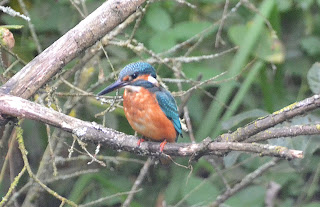Neat Rye
Last
Wednesday I made a trip down to the RSPB Nature Reserve at Rye Meads near Hoddesdon, in Hertfordshire. An area I have the misfortune to know
reasonably well as a result of working between 1986 and 2002 for a company whose
head office was based there.
I must say
straight away, that this was by far and away the most pleasant visit I have made
to the area. Rye Meads is an excellent Reserve comprising of a variety of
wetland habitats, including lagoons, pools, reed beds and scrapes, plus meadows
and a section of the River Lee. Hides (ten) and observation platforms are positioned
along 1.3 km of paths overlooking the various habitats. The reserve supports
birds such as wildfowl, waders and bitterns, as well as many other kinds of
wildlife including water vole and otter.
River Lee at Rye Meads
I had been
recommended the site by a photographer who had advised me it was one of the
best places in the country to see and photograph Kingfishers. I
was also keen to see the artificial nesting bank which had been built there and
which I am told, has successfully been used by breeding pairs of Alcedo atthis
for many years. I have a particular interest in this subject, as it is my hope that our
Friends Group at HESC may be able to build a similar nesting site in the near future,
so that we too can enjoy regular and closer views of these brilliant little
birds.
HESC Kingfisher
On
arrival I was greeted at the visitor centre by RSPB volunteers, who confirmed
that as a RSPB member, car parking was free (£2.00 otherwise) and that there
was no charge for entry to the site. They gave me instructions on finding the
Kingfisher Hide and I was pleased to learn that the designer of the nesting
site was also around and would be happy to discuss the construction process
with me.
Ten
minutes later, after a pleasant walk, I settled down in the Kingfisher hide to
await proceedings.
The "Layer Cake" Nest Site at Rye Meads
Soon the flash of azure and orange
heralded the arrival of the male Kingfisher who perched on a post in front of
the nest site. Unfortunately, this revealed another fact that was to unfold,
throughout the next three hours. Much to my and the other happy snappers
dismay, the post in question was a favourite spot for both the male and female
bird, it was also well out of comfortable range for any lens with a focal
length of less than 500mm.
There
were several other possible perching points around the pool, many much closer
to the hide and the anticipatory lenses, but, despite many prayers, pleas and
oaths being muttered by the hopeful (desperate) throng, the birds remained just
out of effective range to all of us, except those, lucky enough, to be armed
with big bertha glass.
During
my wait, I was however, able to meet with Keith Bedford who had designed and
built the artificial nest site and was able to learn exactly how the layer cake
of concrete and sand was constructed and to take notes for hopefully future use
at HESC.
The
timing of my visit could have been better, as the first brood of young “Alcedos”
had fledged about five days earlier and as is the way with Kingfishers, had
departed the nest area soon after to find their own way in the world. Ma and Pa
meanwhile had started on the second brood which meant the female spent quite a
lot of time in the nest hole, whilst Dad perched nearby or went off scouting
for fish. It will be another six weeks or so before the next brood fledge and
so I will be monitoring the Rye Mead blog in order to plan another visit, when
hopefully there will be more (and closer) activity around the pool.
Having
spent so long in one hide, I had not left much time to visit the rest of the
reserve, but was able to call in at three more hides on the way back to the
car. In particular I enjoyed the Draper hide, where I was able to see waterfowl,
terns and a pair of Little Ringed Plover, sharing spits and islands of land, within
easy viewing range of the hide, whilst a Little Grebe fed under my feet. I also
encountered a fox walking across the path in front of me with a chicken in its
mouth. I was later advised this was a local character by the name of Elsie.
I thoroughly
enjoyed my visit to Rye Meads, which is about an hour and ten minutes drive from
Milton Keynes where I live and intend to visit again before the summer is out.
Who knows, maybe I can justify the expense of a new lens to get the best out of
the return trip.






Cake? Did someone just mention cake? I'll put the kettle on.
ReplyDeleteUnfortunately, Someone left the cake out in the rain - ooh I feel a song coming on!
Delete